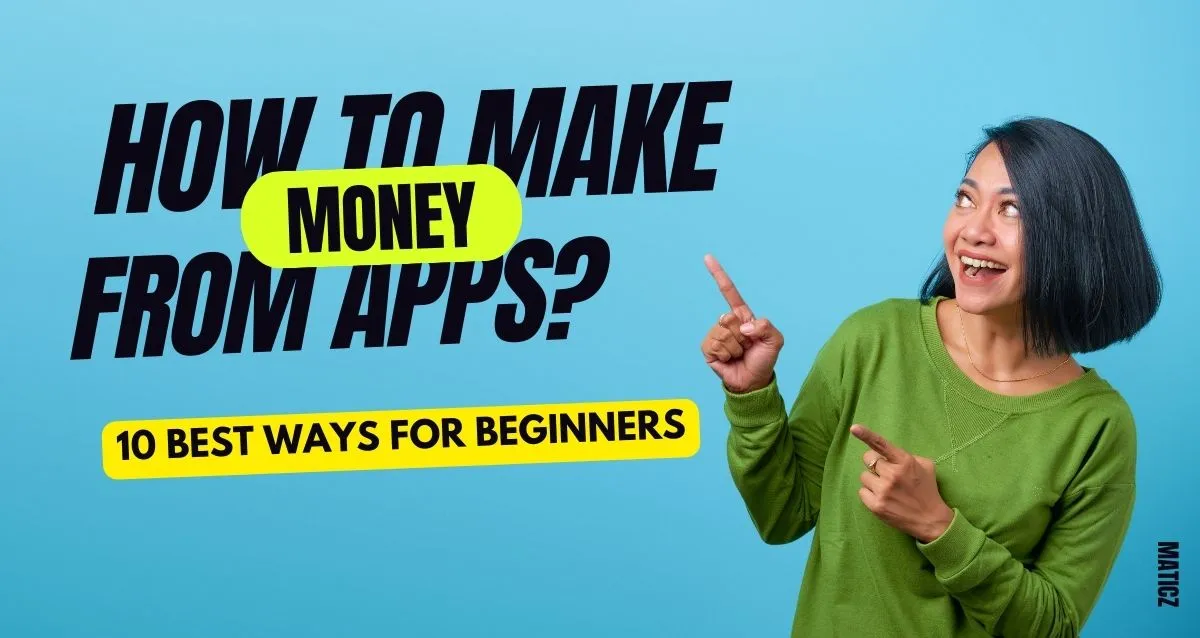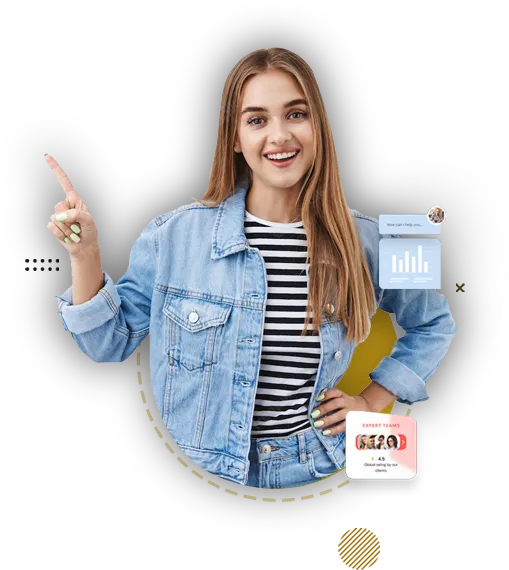Share Posts

Best Money Making Apps in 2025: Make Money From Apps Easily
58
4675
103
These days, mobile apps are a great way to connect and engage with your audience. But, there's always the question on every developer's mind: 'How can I make money from my app?' Whether you're a seasoned pro or just starting, the key is to choose the right monetization models and strategies. In our guide, we'll explore the best ways to monetize your app, giving you insights on how to make your app a profitable venture. We'll cover everything from in-app advertising and in-app purchases to subscription models and innovative ideas. So let's dive into the best possible ways of making money from apps and unlock the potential for financial success in this fast-growing world.
How to Make Money from Apps?
There are various ways to make money from apps. In this digital era, mobile apps have become an essential part of our daily lives. They're not only convenient but also offer a great opportunity for app investors and entrepreneurs to earn money.
Whether you're a newbie or an experienced investor, making money from apps can be both exciting and challenging. That's why we've put together a helpful guide to help you navigate the world of app monetization.
We have covered the best money-making strategies and methods, including in-app advertising, subscription models, in-app purchases, and more.
10 Best Ways of Making Money With Apps
Here we have listed down the 10 best ways of making money with apps.
| Best Ways to Make Money | Strategy Overview | Best Apps with this Strategy |
| Advertising | Integrating advertisements within the apps such as banner ads, in-app video ads, native ads, etc. | Youtube, Facebook, Instagram |
| Subscription | Implementing subscription plans with different layers offering varying levels of access and benefits. | Netflix, Spotify, Twitch |
| Sponsorship | Partner with the brands or businesses that coordinate with your app’s goals and users. | Snapchat, Twitch, Instagram |
| Selling Merchandise | Selling branded merchandise that aligns with your app’s identity and users. | Amazon, Flipkart, Etsy, Walmart |
| In-App Purchases | Offering additional features, virtual goods, and extra features for purchases with the app. | Candy crush saga, Clash of clans, Roblox |
| Affiliate or Referral Marketing | Promoting products or value-added services to the app's audience. | Amazon associates, eBay, Rakuten, Apple app store |
| Collecting and Selling Data | Extracting and providing data to third parties seeking to gain insights on user behavior and preferences. | Pawns.app, Traffmonetizer, MobilExpression |
| Transaction Fees | Charging transaction fees for purchases or bookings with the app | Venmo, PayPal, CashApp |
| Crowdfunding | Raise funds for app development or expansion | Kickstarter, Indiegogo, GoFundMe, Patreon |
| Freemium Upsell | Charging for premium features of the app but users can access core functionalities of the app for free. | Spotify, Headspace, Duolingo, Tidal |
1. Advertising Model
Advertising is the most common way to make money through free apps. According to Statista, the amount spent on mobile advertising was USD 327.1 billion in 2024 and it is expected that there will be an increase of 17.2 % reaching USD 399. 6 billion in the year 2026. You will get paid every time users click the ad or just view it. If they go to the next extent and install the application or program advertised, you will be paid more. In a free version app, you can increase your revenue by collaborating with third-party networks and running their ad campaigns for a particular period. There are many types of In-app ads. Some of the popular ones are listed below.
Interstitial Ads
Interstitial Ads are full-screen ads that appear on the interface of the users’ app or website for a particular time frame. Users can close this ad but the timing of the closing option varies depending on the ad type. Most of the interstitial ads take at least 5 to 10 seconds to display the closing option for the users to continue what they were doing previously. They often come as a cost-per-click model. You can earn money each time the ad is displayed or clicked. It is the ideal way to provide users with access without charging them while earning revenue.
Banner Ads
This type of app advertisement is shown in high-visibility locations where users’ attention easily gets caught such as the top, bottom, or side parts of the app screen. They often pop in as an image or multimedia with an engaging text and Call To Action (CTA). These are displayed to generate leads and purchases through clickthroughs. They come in different sizes big and appealing enough to make users stay on it. Without you having to do anything, through banner ads you will get paid by advertisers.
In-app Video Ads
With the growing popularity of video content, video content marketing has become a lucrative market that many advertisers have tapped into recently. In-app video ads are embedded or tapable video content that lets users watch the video inside the app itself. Generally, these types of ads are given as reward videos, a part of in-app rewards for users. You can earn revenue from the advertisers if the users watch, click on, or purchase the app or product being promoted in your free version app.
Native Ads
Sometimes users get irritated and disturbed by random advertisements which may result in them uninstalling your application. This is where native ads come in which are used as a natural element that matches the look and feel of your app. They don’t look like advertisements and fit in natively making it difficult to recognize them. Users cannot find common call-to-action words such as subscribe, sign up, etc. It might pay you less compared to other monetization models but is seen as a popular and effective strategy to generate consistent revenue.
Rewarded Videos
This is the only advertising model that is beneficial for app owners, advertisers, and online users. Users watch these video advertisements in return for points, extra life, puzzle hints, and virtual stuff. Rewarded videos are highly popular among app owners because they boost their revenue and help keep users engaged with their app. But if you want to succeed with rewarded video ads, then you need to decide when you would display them and make users think it is worth their time to watch them. Surely, it will help you drive more revenue than you expect.
2. Subscription Model
The subscription-based model has become increasingly popular in recent days. If you are not really into advertisements, then consider selecting this model. If users are given access to a limited version of your app for free. You can give users premium features like ad removal, exclusive content, and many others like these in the subscription model. Many applications use the subscription model such as Spotify, Tinder, Hulu, etc.
For those who are wondering how you can make money with a subscription model in the free app, you need to offer a free version with limited features or for a limited amount of time. You can charge users to use the premium features of your application. Then users who are impressed with your app would like to access full content without any restrictions. One of the effective ways to make users opt for your subscription model is to give them free access to a limited version of high quality.
3. Sponsorship Model
Sponsorship is a type of app monetization model that can reap more benefits when it is done right. It is ideal for those apps with an existing strong user base. The sponsorship model is all about partnering with brands and businesses that align with the users and theme of your app. Some apps are made solely for monetization purposes. Some of the common sponsorship ideas are in-app branding, sponsored content, and exclusive promotions.
So before developing it, you can customize your app idea in such a way that it suits the sponsors with whom you want to have sponsorship. The one way you can boost your revenue is to connect with sponsors whose brand and app match your app design and idea. There are two types to deal with revenue, you can set a certain monthly subscription fee and another one is that the revenue of the app is divided equally.
4. Selling Merchandise Model
If your mobile application has managed to establish a strong brand or a loyal user community, you can explore the option of generating additional revenue by selling branded merchandise. Branded merchandise can take various forms such as clothing, accessories, or digital items like stickers and icons. However, to make this model successful, it is crucial to create merchandise that is not only visually appealing but also aligns with your app's identity and resonates with your users' interests.
To create compelling merchandise, you need to understand your users' preferences, their demographics, and their buying behavior. Limited-edition items are an excellent way to generate a sense of urgency and exclusivity that can encourage purchases from your loyal fan base. Additionally, you can leverage your app's social media presence to promote your merchandise and engage with your audience. By doing so, you can build excitement around your branded merchandise, foster a sense of community, and ultimately increase your revenue.
5. In-App Purchases Model
In-app purchases (IAPs) have become an increasingly popular monetization strategy for app developers, especially in the gaming and content-driven categories. By offering virtual goods, premium content, or extra features for purchase within the app, developers can generate a lucrative revenue stream while providing users with a more personalized and enjoyable experience.
However, it's important to ensure that the purchased items are not essential for basic functionality and instead, enhance the user experience. This not only keeps users engaged but also instills a sense of trust and loyalty in them. Regularly updating and introducing new IAPs can further enhance user engagement and encourage them to spend within the app.
In addition, developers need to be transparent and provide clear information about the cost, benefits, and terms of the purchase to avoid any misunderstandings or user dissatisfaction. By doing this, developers can create a positive and sustainable revenue model that benefits both the app and its users in the long run.
6. Affiliate or Referral Marketing Model
Affiliate or referral marketing is a popular approach to monetize your app by promoting products or services relevant to your app's audience. Essentially, you partner with affiliate companies or individuals to promote their products to your audience. For every successful referral or sale made through your affiliate links, you earn a commission.
To succeed in affiliate marketing, it's crucial to select the right affiliate partners that align with your app's niche and add value to your users. You want to choose partners whose products or services are of high quality and whose values align with your own. By doing so, you can build trust with your audience and increase the likelihood of successful referrals. Let’s take a look at some of the cost models that offer unique advantages.
Cost-Per-Mille (CPM)
Cost-Per-Mille, also known as Cost-Per-Thousand, is a cost model where affiliates earn a commission based on the number of impressions of the affiliate's promotional content. In CPM, advertisers pay a fixed amount for every 1,000 impressions of their ad, regardless of whether the viewer takes any further action.
Cost-Per-Click (CPC)
Cost-per-click is a performance-based model where affiliates earn a commission for every click generated through their referral links. Advertisers pay affiliates based on the number of visitors who click on the affiliate's link and visit the advertiser's website. CPC is a common model for driving traffic and can be effective in measuring the effectiveness of different affiliates in generating interest.
Cost-Per-Sale (CPS)
Cost-Per-Sale, also known as Cost-Per-Action (CPA), is a model where affiliates earn a commission when their referrals make a purchase or perform a specific action on the advertiser's site. Affiliates receive a predetermined percentage of the sale's value or a fixed amount. CPS is often considered the most performance-driven cost model as it directly ties compensation to actual conversions.
Cost-Per-View (CPV)
Cost-per-view is a model primarily used in video advertising. Affiliates earn a commission when their referrals watch a specific video or video ad. Advertisers pay based on the number of views, making it an effective model for video content promotion.
Cost-Per-Install (CPI)
Cost-per-install is commonly used in mobile app marketing. Affiliates earn a commission for every user who installs the advertiser's mobile app through their referral link. This model is popular in the app industry, where acquiring new users is crucial.
7. Collecting and Selling Data Model
Mobile applications have the potential to generate revenue by gathering and selling anonymized, aggregated user data to third-party entities. To ensure ethical and privacy-compliant data collection, app developers must adhere to stringent data protection regulations. By extracting and providing useful insights, app owners can sell data to market research firms, businesses, or organizations seeking to gain a comprehensive understanding of user behavior and preferences.
However, transparency and data privacy play a pivotal role in this model, as it is imperative to maintain user trust and confidence in the app. Therefore, app developers need to take necessary measures to safeguard user data and ensure that the collected data is used only for legitimate purposes.
8. Transaction Fees Model
If your mobile application or website facilitates transactions between users or businesses, you can generate revenue by charging transaction fees. To ensure security and reliability, it is essential to implement a robust payment processing system that meets industry standards and complies with relevant regulations. In addition, it is important to define a transparent fee structure that clearly outlines the costs associated with using your platform. This will help build trust with your users and prevent any confusion or disputes over fees.
To make this business model profitable, it is crucial to strike a balance between competitive transaction fees and a seamless user experience. Research your competitors' fee structures to ensure yours is competitive, but don't sacrifice the quality of your service in the process. By keeping your fees reasonable and providing a reliable and user-friendly platform, you can attract and retain customers and generate a steady stream of revenue.
9. Crowdfunding Model
Crowdfunding is an increasingly popular method of raising funds for app development or expansion. Platforms such as Kickstarter, Indiegogo, and GoFundMe provide an opportunity for app developers to present their ideas to potential backers, and in turn, receive the necessary financial support. To attract backers, app developers can offer exclusive rewards, such as early access to the app or additional features, to incentivize potential supporters.
Additionally, crowdfunding allows app developers to engage with a community of backers who are passionate about the project and invested in its success. Crowdfunding can be an effective means of financing app projects, as it not only provides the necessary funding but also serves as a platform for building a community of supporters and advocates for the app.
10. Freemium Upsell Model
The freemium model is a popular strategy that allows app developers to offer a basic version of their product for free while gating premium features behind a paywall. This approach enables users to access core functionalities without charge, but enticing premium features can be unlocked through in-app purchases or subscriptions.
To ensure success with the freemium model, it's essential to offer enough value in the free version to retain users while incentivizing them to upgrade for additional benefits. This could include providing advanced functionality, exclusive content, or additional customization options to paying users.
It's also important to carefully balance the features available in the free and paid versions of the app. While the free version should provide enough value to entice users to try the app, it shouldn't include so many features that users have no reason to upgrade. At the same time, the paid version should offer enough additional benefits to justify the cost and encourage users to upgrade.
By implementing the freemium model effectively, developers can attract a large user base while generating revenue from paying customers. However, it's critical to carefully consider the balance of features and benefits to ensure the model's success.
Best Money Making Apps
Looking for easy and fun ways to make some extra cash in your spare time? Look no further than these amazing money-making apps. Whatever your interests and hobbies may be, these apps offer a variety of ways to earn money, from sharing your thoughts and opinions to playing games and even shopping. So why not try them out and start increasing your earnings today?
1. Swagbucks
2. Survey Junkie
3. Rakuten
4. TaskRabbit
5. Fiverr
6. Ibotta
7. Upside
8. DoorDash
9. Google Opinion Rewards
10. Shopkick
Swagbucks
Swagbucks is a popular reward and cashback platform that offers tons of ways to earn some extra cash. You can earn Swagbucks (SB) just by doing things like taking surveys, watching videos, shopping through the platform, and even searching the web. And the best part? It is possible to exchange your Swagbucks for PayPal cash or gift cards. With its user-friendly interface and variety of tasks, Swagbucks is a fun and easy way to make some extra dough while hanging out online.
| Pros | Cons |
| Diverse earning options: Surveys, Videos, and Shopping. | Limited gift card options and delayed cash. |
| User-friendly interface | Occasional technical glitches |
| Flexible rewards: Cash via PayPal or Gift Cards | Low payouts for some activities |
| Bonus Opportunities: Signups and Referrals | Limited survey and offer eligibility |
Google Opinion Rewards
Google Opinion Rewards is a super user-friendly mobile app that lets you earn Google Play Store credit by answering short surveys. The whole process is easy peasy and takes just a few minutes. The questions are all about your preferences and experiences, so it's like having your voice heard. Once you complete a survey, you'll get rewarded with Google Play Store credit, which you can use to buy apps, online games, movies, and more. It's a great way for Android users to accumulate digital currency without any hassle. Give it a try.
| Pros | Cons |
| Easy-to-use interface | Infrequent surveys |
| A quick survey that can be done in minutes | Repetitive surveys |
| Google Play credits as rewards | Small rewards |
| Tailored surveys | The app is unavailable in some countries |
Shopkick
Shopkick is an awesome app that rewards you for your shopping activities, both online and in-store. All you have to do is walk into stores, scan product barcodes, make purchases, or submit receipts to earn kicks. And guess what? These kicks can then be redeemed for gift cards, merchandise, or even PayPal cash. Shopkick makes shopping even more fun as you get to explore stores, discover new products, and earn money at the same time. While you do your shopping, it is an excellent opportunity to earn some additional money.
| Pros | Cons |
| Diverse reward options for scanning barcodes | Technical glitches |
| Simple and easy-to-use interface | Limited earning potential |
| Wide range of gift card options | Requires in-store presence |
| Points can be earned without purchases | Delayed accumulation of rewards |
Survey Junkie
Survey Junkie is a popular app that rewards users for participating in online surveys. You can earn points by completing surveys on various topics, including brands, products, and market trends. These points can be redeemed for cash or gift cards from popular retailers. With a user-friendly interface and a wide range of survey opportunities, Survey junkie offers a convenient way for individuals to make money in their spare time.
| Pros | Cons |
| A broad range of surveys | Delayed payout processing time |
| Straight forward interface | Limited survey availability based on demographics |
| Cash rewards and gift cards for completing surveys | Requires minimum balance to redeem rewards |
| Regular earning opportunities | Users get disqualified from surveys due to pre-screening questions. |
Rakuten
Rakuten is a famous cashback and shopping rewards app that allows users to earn money back on their online purchases. Users can shop through the app at participating retailers and earn cashback in the form of Rakuten points, which can then be redeemed as PayPal cash or gift cards. Overall, Rakuten provides a convenient way for users to earn rewards while shopping online.
| Pros | Cons |
| Can earn cashback | Delayed cashback processing time |
| Exclusive deals or discounts | Limited availability in international countries |
| Additional rewards for referrals | Cashback rates vary between retailers |
| The app is easy to navigate | Minimum payout threshold |
Fiverr - Freelance Service
Fiverr is a popular freelance service platform where businesses and individuals can connect to buy and sell a wide range of digital services. Users can find freelancers offering services such as graphic design, writing, programming, and more. This app provides a more suitable way for freelancers to showcase their skills and for buyers to find affordable digital services for their projects.
| Pros | Cons |
| Access to a diverse pool of freelance talent | Service quality can vary |
| Convenient communication and transactions | Charges can add up |
| Flexible hiring options and custom offers | Limited ability to bargain outside the platform |
| Transparent reviews and ratings | Takes time to find the right freelancer |
Upside
Upside is a cashback app that focuses on saving money on gas purchases. Users can earn rewards when they fill up gas at participating gas stations, with cashback deposited directly to their bank account. This app’s intuitive interface makes it easy to track savings and manage rewards. It offers a simple and convenient way to save fuel costs on every purchase.
| Pros | Cons |
| Save cost on regular gas expenses | Delayed cashback processing time |
| Simple UI for finding nearby gas stations and redeeming rewards | Technical issues questioning app reliability |
| Cashback rewards on gas purchases | Limited availability of participating gas stations |
| Bonus on referrals | Dependency on partnered gas stations |
DoorDash
DoorDash is a leading on-demand food delivery app that enables users to order food from a wide selection of restaurants and get it delivered to their doorstep. This app's user-friendly interface and real-time tracking system allow their customers to monitor the progress of their orders from the moment they are placed till they arrive at their doorstep. This app helps restaurants reach a wide range of audience and increase their sales through Doordash’s extensive network.
| Pros | Cons |
| Wide selection of restaurants | Service and delivery fees |
| Flexible delivery options | Price varies in the app due to markup |
| Simple interface | Delay in delivery or incorrect delivery |
| Rewards and discounts for frequent users | Services are available in limited areas |
TaskRabbit
TaskRabbit is a platform that connects people with skilled taskers who can help with various tasks and errands. Users can hire taskers for services like cleaning, moving, furniture assembly, and more. This app offers a seamless experience, where users can book, pay and communicate easily with taskers. With a wide range of services and trusted taskers, TaskRabbit simplifies everyday tasks for busy individuals.
| Pros | Cons |
| Easily connect with local taskers for various tasks | Hiring taskers can be expensive |
| Options to choose taskers based on availability, and pricing | Quality of services may vary |
| Saves time for busy individuals | Limited availability of taskers |
| Offers insurance coverage on tasks and provides reassurance | Additional service fees |
Ibotta
Ibotta is a popular cashback app that allows users to earn money back on everyday purchases by scanning receipts or linking loyal accounts. Users can browse offers from various retailers, including grocery stores, pharmacies, and online merchants, and earn cash rewards by purchasing eligible products. This app also offers rewards for completing specific tasks or reaching spending milestones.
| Pros | Cons |
| Easy cashback on everyday purchases | Efforts needed to scan receipts for cashback |
| Wide range of retailers and product coverage | Offer restrictions and limitations apply |
| Bonuses for cashback and spending milestones | Delayed cashback processing |
| Flexible redemption options | Limited availability for specific regions or retailers |
Difference Between Free Apps and Paid Apps
Free apps and paid apps are two distinct monetization strategies in the world of mobile applications. Free apps are offered to users at no upfront cost, allowing them to download and use the app without making a payment. Revenue is generated through various means, such as in-app advertising, in-app purchases, and subscriptions. These apps have a broader user base but may require a well-planned monetization strategy to turn users into paying customers.
On the other hand, paid apps require users to make an upfront payment to download and access the app. Once purchased, users have access to the full range of features without encountering ads or limitations. This model offers a straightforward approach to monetization, with revenue generated directly from app sales. However, it may limit the potential user base, and the app needs to deliver exceptional value to justify the upfront cost.
Bottomline
If you're looking to make your mobile app a financial success, it's important to choose the right money-making strategy. There are plenty of options to choose from, such as in-app ads, freemium models, subscriptions, and in-app purchases. The key is to find the strategy that best suits your app's unique needs and goals. But with a little experimentation and adaptation, you can find the perfect money-making strategy for your app. If you want to figure out the best app monetization model for your app, then reach out to Maticz, the leading mobile app development company that can help you choose the right one for you.
Tap Into the Future
The latest insights, posts, and project updates - straight to your inbox.




